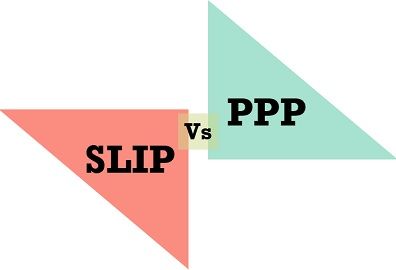 SLIP and PPP are the two distinct independent serial link encapsulation protocols. The significant difference between the SLIP and PPP is that SLIP is the earlier version protocol while PPP is the later variant which gives several advantages over SLIP such as detection and prevention of misconfiguration, etcetera. Furthermore, PPP supplies greater built-in security mechanism.
SLIP and PPP are the two distinct independent serial link encapsulation protocols. The significant difference between the SLIP and PPP is that SLIP is the earlier version protocol while PPP is the later variant which gives several advantages over SLIP such as detection and prevention of misconfiguration, etcetera. Furthermore, PPP supplies greater built-in security mechanism.
These protocols involve just two devices and between those two devices, the straightforward communication takes place. It provides connectivity on the second layer for TCP/IP implementations.
Content: SLIP Vs PPP
Comparison Chart
| Basis for comparison | SLIP | PPP |
|---|---|---|
| Relation | Predecessor protocol | Successor protocol |
| Encapsulates | IP packets | Datagram |
| Supports | Only IP | Including IP layer three protocols are also involved |
| Authentication | Not provided | Proper authentication is performed. |
| Derivative Protocols | CSLIP (Compressed SLIP) | PPPoE (PPP over Ethernet) and PPPoA (PPP over ATM) |
| IP addressing | Static assignment | Dynamic assignment |
| Data transfer | Synchronous | Synchronous as well as asynchronous |
Definition of SLIP
The SLIP (Serial Line Internet Protocol) mainly serve the purpose of framing the IP packets along the serial lines mostly in a dial-up connection where the line transmission rate could be in the range of 1200 bps and 19.2 Kbps. However, there is no provision of for addressing, packet type identification, compression or error detection/correction mechanisms but it is easily implemented.
The SLIP was first introduced in the year of 1984 and implemented on the 4.2 Berkeley and Sun Microsystems Unix platforms. The development of slip is stimulated by the availability of Unix workstation enabled with TCP/IP capabilities. Later, the SLIP protocol development moved to personal computers when the personal computers evolved to support TCP/IP.
A SLIP connection facilitates PCs communication with the native Internet Protocol and turns it into an internet host. It eliminated the need of connecting the PC user to the internet connected central computer. So, SLIP provided the internet services to the personal computers directly.
Now, how does these PC’s are connected to the internet? For establishing the connection between a PC and internet router (able to transfer TCP/IP protocols), telephone lines are used along with SLIP support. Practically, these internet routers can be internet host enabled with routing functions.
Hence, the SLIP protocol users physically connect to the central computer through dial-up. After initiating the protocol, the users can access other internet hosts transparently and the central computer starting as a part of the internet infrastructure.
Definition of PPP
PPP (Point-to-Point) protocol render a standard method for the transfer of the multiprotocol datagrams (packets) along a point-to-point link. The main elements of PPP are – a mechanism for encapsulating multi-protocol datagrams, LCP (Link Control Protocol) and a group of NCP (Network Control Protocols). LCP mainly sets up, configure and test the connections while NCP is responsible for establishing and configuring the distinct network layer protocols.
The PPP was developed by the IETF (Internet Engineering Task Force) in November 1989. As the antecedent, the non-standard method SLIP did not support features such as error detection and correction, and compression gave rise to the development of the PPP protocol. The earlier existing standard only assist datagram encapsulation for the popular local area network not for the serial connections.
PPP has emerged as an internet standard which facilitates in encapsulation and transfer of the datagrams over the point-to-point serial link. A datagram very similar to a packet in the context of the packet-switched network, but it does not rely on the physical network and does not contain packet switching node number and PSN destination ports.
Key Differences Between SLIP and PPP
- The SLIP expands to Serial Line Internet Protocol while PPP stands for the Point-to-Point protocol.
- SLIP is an outdated protocol, though it is still used in some places. It is good for just bridging the gap between the IP at layer 3 and serial link at layer 1. On the other hand, PPP is the newer protocol used for the same purpose as the SLIP but offer several new features.
- SLIP encapsulates IP packets while PPP encapsulates datagram.
- IP protocol is the only protocol supported by SLIP. On the contrary, PPP provides support for the other layer three protocols also.
- PPP offers authentication, error detection, error correction, compression, encryption whereas SLIP does not have these features.
- In SLIP the IP addresses are statically allocated. Conversely, PPP performs the dynamic assignment.
- Data can be transferred in synchronous mode in SLIP. As against, PPP facilitates synchronous and asynchronous modes for data transfer.
Advantages of PPP over SLIP
- Multiplexing of network protocols – PPP can adapt several other networking technologies, rather than just restricting to the internet and TCP/IP.
- Link configuration – It employs a negotiation mechanism for setting up communication parameters between two PPP peers.
- Error detection – At the receiving end, it discards the corrupted packets.
- Value added communication characteristics – It also supports data commpression and encryption.
- Establishing network addresses – It sets network addresses required for the datagram routing.
- Authentication – Before initiating the communication, the two end users are authenticated first.
Conclusion
The SLIP and PPP protocol are used to provide the point-to-point serial communication between the two hosts. Since PPP is latter and advanced protocol, it offers several additional features along with just providing the point-to-point services.
Leave a Reply